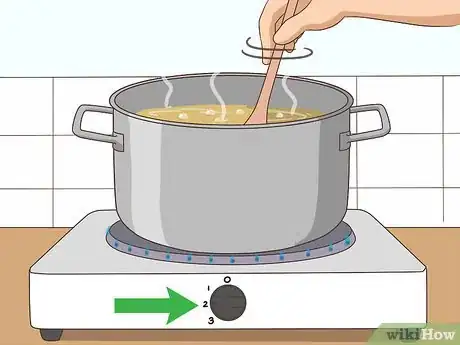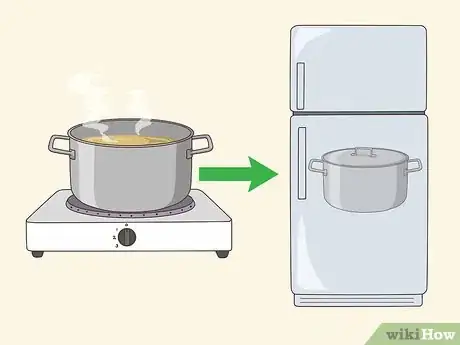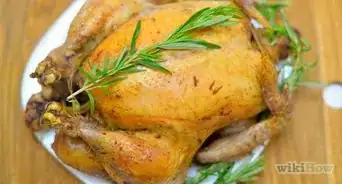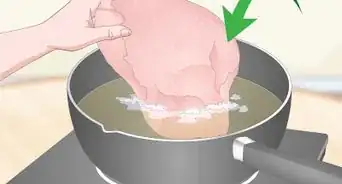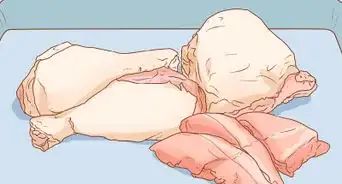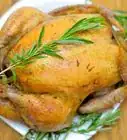This article was co-authored by JoAnna Minneci and by wikiHow staff writer, Jessica Gibson. JoAnna Minneci is a Professional Chef based in the Nashville, Tennessee area. With more than 18 years of experience, Chef JoAnna specializes in teaching others how to cook through private cooking lessons, team-building events, and wellness and nutrition classes. She has also appeared in numerous television shows on networks such as Bravo and Food Network. Chef JoAnna received Culinary Arts training from the Art Institute of California at Los Angeles. She is also certified in sanitation, nutrition, kitchen management, and cost control.
wikiHow marks an article as reader-approved once it receives enough positive feedback. In this case, 100% of readers who voted found the article helpful, earning it our reader-approved status.
This article has been viewed 343,791 times.
If you dread tough or dry turkey, take the time to brine it before roasting. Create a flavorful solution of vegetable stock, salt, and seasonings. Submerge a thawed turkey in the brine along with lots of ice water and leave it to chill for at least 8 to 16 hours. Remove the turkey from the brine and pat it dry. Then roast the turkey until it reaches 165 °F (74 °C) and enjoy!
Ingredients
- 1 14 to 16 lb (6.4 to 7.3 kg) frozen young turkey
- 1 cup (288 g) kosher salt
- 1/2 cup (100 g) light brown sugar
- 1 gallon (3.8 l) vegetable stock
- 1 tablespoon (9 g) black peppercorns
- 1 1/2 teaspoons (1.5 g) allspice berries
- 1 1/2 teaspoons (6 g) chopped candied ginger
- 1 gallon (3.8 l) ice water
Makes a 14 to 16 lb (6.4 to 7.3 kg) turkey
Steps
Thawing the Turkey and Making the Brine
-
1Move the frozen turkey to the refrigerator 2 to 3 days before cooking. Take the 14 to 16 lb (6.4 to 7.3 kg) frozen young turkey from the freezer and place it in the refrigerator to thaw completely. This should take 2 to 3 days.[1]
- Your refrigerator should be 38 °F (3 °C) or cooler.
-
2Mix the salt, sugar, stock, pepper, allspice, and ginger. Place a large stockpot on the stove and pour 1 gallon (3.8 l) of vegetable stock into it. Stir in 1 cup (288 g) of kosher salt, 1/2 cup (100 g) of light brown sugar, 1 tablespoon (9 g) of black peppercorns, 1 1/2 teaspoons (1.5 g) of allspice berries, and 1 1/2 teaspoons (6 g) of chopped candied ginger.[2]Advertisement
-
3Bring the brine to a boil. Turn the burner to medium-high and stir the brine every once in a while as it heats. The brine should begin to boil as the sugar dissolves.
[3] -
4Cool and refrigerate the brine. Turn off the burner and let the brine cool until it's at room temperature. Put the lid on the stockpot and transfer it to the refrigerator to chill while the turkey thaws.[4]
- If your stockpot won't fit in the refrigerator, pour the brine into a storage container with a lid. Put the container in the fridge.
- You can make the brine a few days before you plan to roast the turkey.
Submerging the Turkey in Brine
-
1Mix the brine with 1 gallon (3.8 l) ice water in a large container. On the morning of the day you want to roast the turkey or the night before, remove the brine from the refrigerator. Pour it into a 5 US gal (19 l) food-safe bucket or cooler. Mix in the ice water.[5]
- Consider using a 5 US gal (19 l) drink cooler. These have good insulation and a drain spout for easy clean up.
-
2Submerge the thawed turkey in the brine. Take the turkey from the refrigerator and remove the innards. Discard the innards and the pop-up thermometer if your turkey has one. Put the turkey breast-side down in the brine-filled container.[6]
- The turkey should be completely covered in brine. If it isn't, place a heavy plate or dish on the turkey to weigh it down.
-
3Chill the turkey in the brine for 8 to 16 hours. Cover the bucket and refrigerate the turkey while it brines. If you're using a cooler with a lid, screw the lid on and leave it in a cool place while the turkey brines.[7]
- The cooler with the turkey and brine should keep the turkey at 38 °F (3 °C) or below. If you think the cooler isn't keeping the turkey cold enough, refrigerate it.
Roasting the Brined Turkey
-
1Preheat the oven to 500 °F (260 °C) and adjust your oven racks. You may have to remove 1 of your oven's racks in order to fit the turkey inside. Adjust the remaining rack to the lowest part of the oven so you have space to fit the roaster.[8]
-
2Lift the turkey out of the brine and rinse it with cold water. Set the container with the turkey and brine next to your sink. Remove the lid and lift the turkey out of the brine. Run cold water in the sink and rinse the brine off of the turkey.[9]
- Remember to rinse the inside cavity of the turkey as well.
- Discard the brine once you've taken the turkey out of it. Never reuse brine.
Warning: Rinsing a raw turkey can spread harmful bacteria around your kitchen work area. To rinse off the brine safely, wash your sink with hot, soapy water both before and after rinsing. Cover the area around your sink with paper towels to prevent splashing, and keep the roasting pan nearby so you can transfer the turkey into it easily and minimize dripping.[10]
-
3Put the turkey on a roasting pan and pat it dry. If you don't have a roasting pan, put a sturdy wire rack in a large baking dish and set the turkey on it. Use paper towels to completely dry the turkey.[11]
- Drying the turkey will help the skin crisp as it roasts.
-
4Season the turkey if you like and roast it for 30 minutes. If you'd like, put aromatics such as lemon, garlic herb rub made with butter, rosemary, thyme, onions, or herbs in the center of the turkey. Put the turkey into the preheated oven and roast it at high heat for 30 minutes.[12]
-
5Turn the oven to 350 °F (177 °C) and roast the turkey till it reaches 165 °F (74 °C). This should take 2 to 2 1/2 hours. To test if it's done, insert an instant-read meat thermometer into the thickest part of the turkey near the thigh and the wing.[13]
-
6Remove the turkey and let it rest for 15 minutes before you carve it. Turn off the oven and take the turkey out of the oven. Cover it loosely with foil and leave it to rest so the juices redistribute within the meat. Then you can carve and serve your brined turkey.[14]
- Store leftover roasted turkey in an airtight container in the refrigerator for up to 3 to 4 days.
Expert Q&A
-
QuestionIs brining a turkey worth it?
 JoAnna MinneciJoAnna Minneci is a Professional Chef based in the Nashville, Tennessee area. With more than 18 years of experience, Chef JoAnna specializes in teaching others how to cook through private cooking lessons, team-building events, and wellness and nutrition classes. She has also appeared in numerous television shows on networks such as Bravo and Food Network. Chef JoAnna received Culinary Arts training from the Art Institute of California at Los Angeles. She is also certified in sanitation, nutrition, kitchen management, and cost control.
JoAnna MinneciJoAnna Minneci is a Professional Chef based in the Nashville, Tennessee area. With more than 18 years of experience, Chef JoAnna specializes in teaching others how to cook through private cooking lessons, team-building events, and wellness and nutrition classes. She has also appeared in numerous television shows on networks such as Bravo and Food Network. Chef JoAnna received Culinary Arts training from the Art Institute of California at Los Angeles. She is also certified in sanitation, nutrition, kitchen management, and cost control.
Professional Chef Definitely! When you brine, more of that salty water is going to be drawn into the bird, which will pump it up and make it more moist and flavorful on the inside.
Definitely! When you brine, more of that salty water is going to be drawn into the bird, which will pump it up and make it more moist and flavorful on the inside. -
QuestionHow much water, salt, and brown sugar do I need if I am brining a 20 lb turkey?
 Community AnswerA turkey that size should take approximately 3 gallons of water to submerge. I like using 1 cup each of salt and sugar per gallon of water. I would put all 3 cups of salt and sugar in 1 gallon of water and heat to dissolve everything, then add the other 2 gallons of cold water to reduce the temp of the brine so you don't poach the turkey.
Community AnswerA turkey that size should take approximately 3 gallons of water to submerge. I like using 1 cup each of salt and sugar per gallon of water. I would put all 3 cups of salt and sugar in 1 gallon of water and heat to dissolve everything, then add the other 2 gallons of cold water to reduce the temp of the brine so you don't poach the turkey. -
QuestionDo you brine the turkey even if you deep fry the turkey?
 Community AnswerNo. Don’t brine it if you intend to deep fry. Extra water is a bad thing with the oil.
Community AnswerNo. Don’t brine it if you intend to deep fry. Extra water is a bad thing with the oil.
Warnings
- Always use good hygiene practices such as washing your hands and sanitizing your work surfaces when handling raw poultry.⧼thumbs_response⧽
- The USDA doesn’t recommend rinsing raw turkey unless you need to remove excess brine. Rinsing won’t wash away germs effectively, and it can spread bacteria around and increase your risk of getting sick. The best way to get rid of germs is to cook your turkey thoroughly.[15]⧼thumbs_response⧽
Things You'll Need
- Measuring cups and spoons
- Large pot
- Spoon
- 5 US gal (19 l) food-safe cooler or bucket with lid
- Roasting pan
- Paper towels
- Instant-read meat thermometer
- Oven mitts
- Aluminum foil
References
- ↑ https://www.foodnetwork.com/recipes/alton-brown/traditional-roast-turkey-recipe-2010390
- ↑ https://www.foodnetwork.com/recipes/alton-brown/traditional-roast-turkey-recipe-2010390
- ↑ https://www.foodnetwork.com/recipes/alton-brown/traditional-roast-turkey-recipe-2010390
- ↑ https://www.foodnetwork.com/recipes/alton-brown/traditional-roast-turkey-recipe-2010390
- ↑ https://www.foodnetwork.com/recipes/alton-brown/traditional-roast-turkey-recipe-2010390
- ↑ https://www.foodnetwork.com/recipes/alton-brown/traditional-roast-turkey-recipe-2010390
- ↑ https://www.foodnetwork.com/recipes/alton-brown/traditional-roast-turkey-recipe-2010390
- ↑ https://www.foodnetwork.com/recipes/alton-brown/traditional-roast-turkey-recipe-2010390
- ↑ https://www.foodnetwork.com/recipes/alton-brown/traditional-roast-turkey-recipe-2010390
- ↑ https://www.usda.gov/media/blog/2017/11/16/brining-safely-will-bring-tender-flavorful-meat-thanksgiving-table
- ↑ https://www.foodnetwork.com/recipes/alton-brown/traditional-roast-turkey-recipe-2010390
- ↑ https://www.foodnetwork.com/recipes/alton-brown/traditional-roast-turkey-recipe-2010390
- ↑ https://www.foodnetwork.com/recipes/alton-brown/traditional-roast-turkey-recipe-2010390
- ↑ https://www.foodnetwork.com/recipes/alton-brown/traditional-roast-turkey-recipe-2010390
- ↑ https://www.usda.gov/media/blog/2013/11/21/wash-or-not-wash-your-turkey
About This Article
To brine a turkey, first find a pot that’s large enough to hold the turkey and keep it submerged. Then, pour 1 gallon (4 liters) of warm water and 3/4 cup (275 grams) of salt into the pot, and stir until the salt dissolves. Add your favorite herbs and spices for extra flavor, like bay leaf, black pepper, thyme, or even brown sugar. Next, put the turkey in the pot, and place the pot in the fridge. Let the turkey soak in the brine for at least 8 hours. Finally, when you’re ready to cook it, take the turkey out of the brine and rinse it under cool water. For tips on cooking a turkey after you brine it, scroll down!


